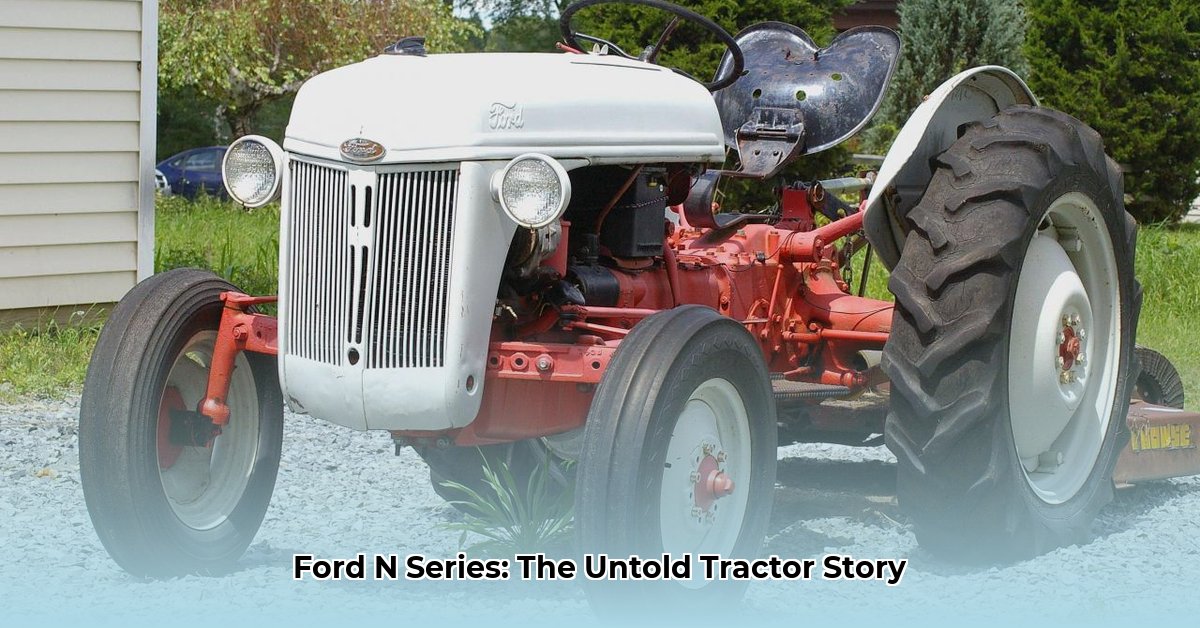
Ford Tractor N Series: A Legacy Forged in Steel
The Ford N-Series tractors—the 9N, 2N, and 8N—were more than just machines; they were transformative tools that reshaped American agriculture. Emerging from the hardships of the Great Depression and further refined during World War II, these workhorses revolutionized farming practices and left an enduring legacy. This article explores their remarkable journey, from innovative engineering to the landmark legal battles that shaped their history. For more on Ford tractors, check out this related site.
The 9N: A Pioneer in Agricultural Technology
Imagine the late 1930s. Farmers, still recovering from the devastating Dust Bowl and the Great Depression, desperately needed reliable and affordable equipment. Enter the Ford 9N, arriving in 1939 as a technological marvel. Its most significant innovation was the integration of Harry Ferguson's three-point hitch system. This revolutionary design allowed for the easy attachment and lifting of implements like plows and harrows, a significant improvement over previous methods. This innovation drastically increased efficiency and reduced the strenuous physical labor previously required. The 9N's immediate impact was profound, boosting productivity and making farming more accessible.
However, the 9N wasn't without limitations. Its 3-speed transmission and relatively modest 13 drawbar horsepower (the pulling power of the tractor) meant it wasn't a powerhouse. Yet, its affordability, combined with the groundbreaking three-point hitch, made it revolutionary and accessible to a much wider range of farmers. Did this balance of affordability and technological advancement account for its immediate success? Undoubtedly.
The 2N: Wartime Adaptation and Resilience
World War II dramatically altered the landscape of production, including for agricultural machinery. The 2N, introduced during the war years, reflected these realities. Raw materials were scarce, factories were retooled for military needs, and design choices prioritized functionality over elaborate refinements. While some improvements were made, such as a larger cooling fan and pressurized radiator to mitigate overheating, the 2N largely retained the 9N's 3-speed transmission reflecting resource constraints. Despite these limitations, the 2N ensured the continuation of farming operations during a critical period, showcasing the ruggedness and adaptability of the Ford N-Series design.
The 8N: A Triumph of Post-War Engineering
The post-war economic boom spurred a surge in demand for more powerful and versatile farm equipment. Ford responded with the 8N in 1947 which was a quantum leap forward. A 4-speed transmission offered enhanced versatility, and significantly upgraded hydraulics provided precise position control of implements, further boosting efficiency. Its 18 drawbar horsepower represented a substantial increase over its predecessors, making it a true powerhouse. But the 8N's success wasn't solely due to technical advancements. Its legendary reliability made it a firm favorite among farmers, solidifying the Ford N-Series' enduring legacy. The 8N became an icon—a symbol of postwar progress and prosperity in American agriculture.
The Ferguson-Ford Dispute: A Landmark Legal Battle
The story of the Ford N-Series is inextricably linked to the famous legal conflict between Harry Ferguson, the inventor of the three-point hitch, and Henry Ford II. This epic battle centered on patent rights for the revolutionary three-point hitch, a system integral to the success of the Ford 9N and its successors. The legal dispute—a landmark case that profoundly reshaped the agricultural machinery industry—highlighted the intense competition and the high stakes involved in developing and marketing groundbreaking agricultural technology. While the specifics remain debated, the outcome undeniably influenced the trajectory of tractor design going forward.
Legacy and Impact: A Lasting Impression on Agriculture
The Ford N-Series tractors' influence on farming practices, tractor design, and the broader agricultural industry is undeniable. The three-point hitch, initially introduced on the 9N, became an industry standard. The 8N’s remarkable commercial success set a new benchmark for tractor design and sales. Even today, these tractors hold immense value, many are still lovingly restored and actively used, a testament to their exceptional durability and efficient design. Their enduring popularity among collectors further underscores their historical significance and lasting impact on the world of farming.
Specifications Comparison: A Glimpse into the Evolution
| Model | Approximate Weight (lbs) | Drawbar HP | Transmission | Hydraulics |
|---|---|---|---|---|
| 9N | 2,340 | 13 | 3-speed | Draft Control |
| 2N | ~2,340 | 13 | 3-speed | Draft Control |
| 8N | ~2,340 | 18 | 4-speed | Position Control |
Note: These figures represent approximate values, and variations may exist due to production changes and different sources.
Key Takeaways:
- Innovation and Adaptability: The Ford N-Series tractors exemplify innovative engineering, adapting to the challenges of the Great Depression and the constraints of World War II.
- Enduring Legacy: The three-point hitch, pioneered on the 9N, became an industry standard, testament to its enduring engineering impact.
- Cultural Significance: The 8N became a symbol of post-war prosperity, showcasing the lasting impact of the N-Series on American agriculture and the culture of farming.